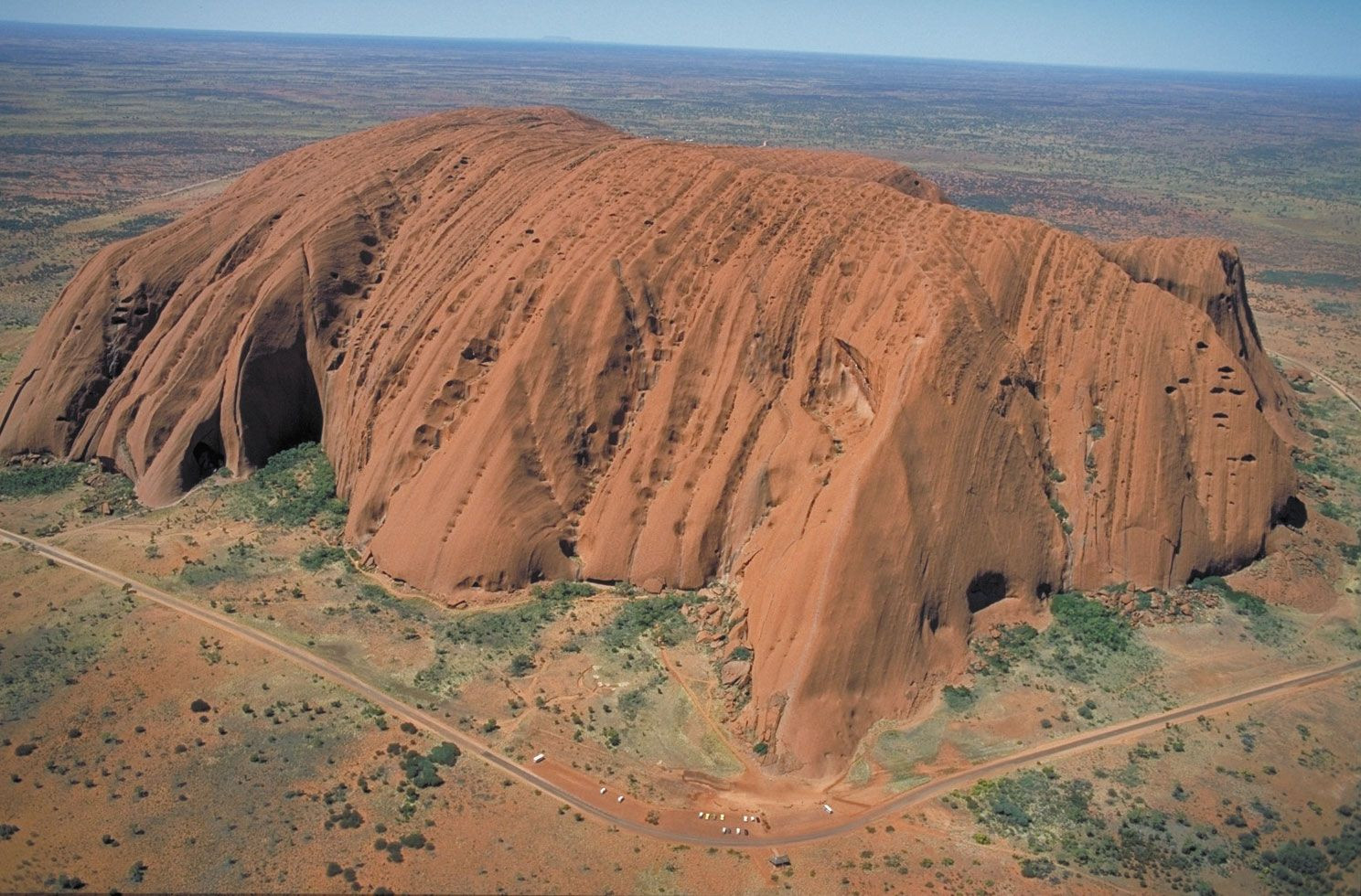Uluru, also famously known as Ayers Rock Of Australia, stands as a colossal sandstone monolith in the heart of the Australian Outback. This iconic landmark, located within the Uluru–Kata Tjuta National Park in the Northern Territory, is not just a geological marvel but also a site of immense spiritual and cultural significance to the Aboriginal people of Australia. Rising dramatically from the desert plains, Ayers Rock captivates visitors with its breathtaking scale, vibrant colors that shift with the sun, and ancient stories etched into its very being.
For millennia, Uluru has been deeply connected to the Aboriginal people, particularly the Anangu, who are its traditional custodians. They know it as Uluru, a name far predating its European moniker, Ayers Rock. While explorer Ernest Giles first sighted the rock in 1872, it was surveyor William Gosse who reached it in 1873 and named it Ayers Rock in honor of Sir Henry Ayers, then the Premier of South Australia. However, to truly understand and respect this natural wonder, it’s crucial to acknowledge its Aboriginal heritage and the name Uluru, which resonates with its ancient past. While Mount Augustus in Western Australia is sometimes debated as larger, Uluru definitively holds the title of the world’s largest monolith due to its singular rock composition, setting it apart from formations composed of multiple rock types.
The sheer size of Ayers Rock is astounding. Towering 1,142 feet (348 meters) above the desert floor and reaching 2,831 feet (863 meters) above sea level, this oval-shaped giant stretches 2.2 miles (3.6 km) in length and 1.5 miles (2.4 km) in width, with a circumference of 5.8 miles (9.4 km). Geologically, Ayers Rock is composed of arkosic sandstone, characterized by a significant feldspar content. This unique composition is responsible for the rock’s dramatic color transformations throughout the day. Ayers Rock is most famous for its fiery orange-red glow at sunset, a spectacle caused by the sun’s rays interacting with the iron oxides in the sandstone. The monolith’s surface is also sculpted by erosion. The softer rock layers have been carved into fluted slopes, while the summit is marked by gullies and basins that transform into cascading waterfalls during infrequent rainstorms, a dramatic sight in the arid landscape. At the base of Ayers Rock, shallow caves hold profound significance, adorned with ancient carvings and paintings that tell stories and embody the sacred traditions of the local Aboriginal tribes.
Ayers Rock is the centerpiece of the Uluru–Kata Tjuta National Park, originally established as Ayers Rock–Mount Olga National Park in 1958 and renamed in 1993 to reflect its Aboriginal and geographical context. The park also encompasses Kata Tjuta, also known as the Olgas, a cluster of domed rock formations located approximately 20 miles (32 km) west-northwest of Uluru. Spanning 512 square miles (1,326 square km), the park is a protected landscape of immense natural and cultural value. In a landmark decision in 1985, the official ownership of Uluru/Ayers Rock was returned to the local Aboriginal Anangu people. They, in turn, leased it back to the Australian federal government for 99 years, ensuring its continued management as a national park while respecting Aboriginal custodianship. Recognizing its universal significance, UNESCO designated Uluru–Kata Tjuta National Park a World Heritage site in 1987, further adding a second designation in 1994 specifically for its profound cultural importance, underscoring the deep connection between the landscape and Aboriginal culture.
The climate surrounding Ayers Rock is characterized by its aridity and extreme temperature variations. The region experiences hot, dry conditions for most of the year, with significant differences between day and night temperatures. Winters, from May to July, are cool, with nighttime temperatures often dipping below freezing. Conversely, the hottest month, December, sees daytime highs frequently exceeding 105 °F (40 °C). Rainfall is scarce and unpredictable, averaging around 12 inches (300 mm) annually, with most precipitation occurring between January and March. Droughts are a common occurrence, shaping the resilient ecosystem of the area.
Despite the challenging climate, the landscape around Ayers Rock teems with life. The national park supports a surprising diversity of flora and fauna. Around 400 plant species thrive here, including mulga trees, desert oaks, desert poplars, various eucalyptus species like centralian bloodwoods, and shrubs like Grevillea. Wildflowers, including foxtails and myrtles, add bursts of color to the arid environment. The wildlife is equally diverse, featuring mammals like red kangaroos, numerous rodents and small marsupials, and the endangered rufus hare wallaby. Reptiles and amphibians are abundant, including geckos, skinks, and venomous snakes like the death adder, as well as the unique indigenous moloch, or thorny devil. Birdlife is prolific, with approximately 175 species, including falcons, buzzards, budgerigars, and honeyeaters, making it a haven for bird watchers.
 Uluru/Ayers Rock, Northern Territory, Australia
Uluru/Ayers Rock, Northern Territory, Australia
Ayers Rock stands as one of Australia’s premier tourist destinations, drawing visitors from across the globe. The most common entry point is via Alice Springs, about 280 miles (450 km) northeast by road. Yulara, a resort town located just outside the national park boundary, also has a small airport with scheduled flights, offering various accommodations from hotels to hostels and campsites, along with restaurants and essential services. Crucially, there are no overnight facilities within the national park itself to preserve its natural integrity. Roads provide access from Yulara to the park, connecting Ayers Rock with Kata Tjuta. Hiking around the base of Ayers Rock remains a popular activity, allowing visitors to appreciate its immense scale and geological details up close. Historically, climbing Ayers Rock was also common; however, the Anangu people strongly discourage climbing, considering it disrespectful to its sacred significance. Out of respect for their wishes and cultural heritage, climbing was officially closed in 2019. To deepen the understanding of Aboriginal culture and the significance of Uluru, the cultural center near the base of the monolith offers insightful exhibits, enriching the visitor experience and promoting cultural sensitivity.
Visiting Ayers Rock of Australia is more than just witnessing a natural wonder; it’s an opportunity to connect with an ancient landscape and learn about the rich cultural heritage of Australia’s Aboriginal people. Uluru remains a powerful symbol of Australia, a testament to both the grandeur of nature and the enduring spirit of indigenous culture.
